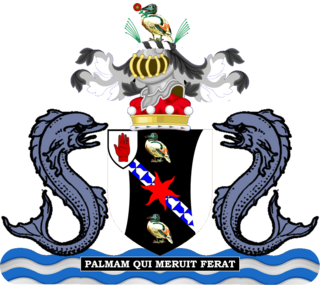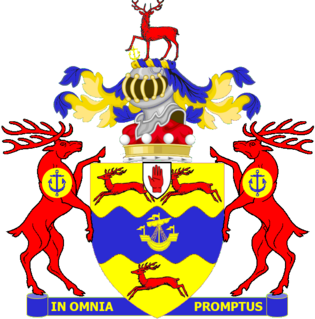
Baron Faringdon, of Buscot Park in the County of Oxfordshire, is a title in the Peerage of the United Kingdom. It was created in 1916 for Sir Alexander Henderson, 1st Baronet, who had previously represented Stafford West and St George's, Hanover Square in the House of Commons as a Liberal Unionist. He had already been created a baronet in 1902. He was succeeded by his grandson, the second Baron. He was the son of the Hon. Harold Henderson, eldest son of the first Baron, who predeceased his father. Lord Faringdon was a member of the London County Council. As of 2017 the titles are held by his nephew, the third Baron, who succeeded in 1977. He is the son of the Hon. Michael Thomas Handerson, second son of the Hon. Harold Henderson.
Baron Howick of Glendale, of Howick in the County of Northumberland, is a title in the Peerage of the United Kingdom. It was created in 1960 for Sir Evelyn Baring, the former Governor of Kenya. A member of the famous Baring family, he was the third and youngest son of Evelyn Baring, 1st Earl of Cromer, and the great-grandson of Sir Francis Baring, 1st Baronet, the founder of Barings Bank. Baring's uncle was Edward Baring, 1st Baron Revelstoke, the father of Maurice Baring, while other members of the family include Francis Baring, 1st Baron Northbrook, and Alexander Baring, 1st Baron Ashburton. As of 2014 the title is held by the first Baron's son, the second Baron, who succeeded in 1973.
Baron Kirkwood, of Bearsden in the County of Dunbarton, is a title in the Peerage of the United Kingdom. It was created in 1951 for the Scottish engineer, trade unionist, Independent Labour Party and later Labour politician David Kirkwood. As of 2010 the title is held by his grandson, the third baron, who succeeded his father in 1970.
Baron Windlesham, of Windlesham in Surrey, is a title in the Peerage of the United Kingdom. It was created in 1937 for the Conservative politician Sir George Hennessy, 1st Baronet. He had already been created a Baronet, of Winchester in the County of Somerset, in 1927. His eldest son, the second Baron, was a Brigadier in the Grenadier Guards. The latter's son, the third Baron, succeeded in 1962; a Conservative politician, he notably served as Lord Privy Seal and Leader of the House of Lords in 1974. In 1999 he was created a life peer as Baron Hennessy, of Windlesham in the County of Surrey, so that he could continue to sit in the House of Lords after the passing of the House of Lords Act 1999, which removed the automatic right of hereditary peers to a seat in the upper chamber of parliament. As of 2015 the titles are held by his son, the fourth Baron.

Baron Newton, of Newton-in-Makerfield in the County Palatine of Lancaster, is a title in the Peerage of the United Kingdom. It was created in 1892 for the Conservative politician William Legh, who had earlier represented Lancashire South and Cheshire East in the House of Commons.

Baron Newall, of Clifton-upon-Dunsmoor in the County of Warwick, is a title in the Peerage of the United Kingdom. It was created on 18 July 1946 for Marshal of the Royal Air Force Sir Cyril Newall. He was Chief of the Air Staff between 1937 and 1940 and Governor-General of New Zealand between 1941 and 1946. As of 2017 the title is held by his only son, the second Baron, who succeeded in 1963.

Baron Strathcarron, of Banchor in the County of Inverness, is a title in the Peerage of the United Kingdom. It was created on 11 January 1936 for the Liberal politician Sir Ian Macpherson, 1st Baronet. He had already been created a baronet, of Drumalban on 26 April 1933. As of 2017, the titles are held by his grandson, the third Baron, who succeeded his father in 2006.

Baron Pender, of Porthcurnow in the County of Cornwall, is a title in the Peerage of the United Kingdom. It was created in 1937 for the former Conservative Member of Parliament for Newmarket and Balham and Tooting, John Denison-Pender. He was the grandson of the businessman Sir John Pender, founder of a number of telegraph companies, Eastern Telegraph, Eastern and South African Telegraph, Europe and Azores Telegraph Company, Australasia and China Telegraph Company, London Platino-Brazilian Telegraph Company, Pacific and European Telegraph Company which later became Cable & Wireless. As of 2016 the title is held by the first Baron's great-grandson, the fourth Baron, who succeeded his father in 2016.

Baron Merthyr, of Senghenydd in the County of Glamorgan, is a title in the Peerage of the United Kingdom. It was created in 1911 for the Welsh coal mining magnate Sir William Lewis, 1st Baronet. He had already been created a baronet, of Nantgwyne in the County of Glamorgan, in 1896. The barony is named after the town of Merthyr Tydfil, where Lewis was born. Lord Merthyr's grandson, the third Baron, was Chairman of Committees in the House of Lords from 1957 to 1965 and a Deputy Speaker from 1957 to 1974. The latter was succeeded by his son, the fourth Baron. He disclaimed the peerage for life on 26 April 1977, three weeks after succeeding his father. He did not use his title of baronet either. He died on 5 August 2015.
There have been several hereditary and life peerages created for persons with the surname Morris, all in the Peerage of the United Kingdom.

Baron Coleridge, of Ottery St Mary in the County of Devon, is a title in the Peerage of the United Kingdom. It was created in 1874 for the prominent lawyer, judge and Liberal politician Sir John Coleridge. He served as Lord Chief Justice of England from 1880 to 1894. His son, the second Baron, represented Attercliffe in the House of Commons and served as a Judge of the High Court of Justice. As of 2010 the title is held by the latter's great-grandson, the fifth Baron, who succeeded in 1984.
Baron Cawley, of Prestwich in the County Palatine of Lancaster, is a title in the Peerage of the United Kingdom. It was created in 1918 for the Liberal politician Sir Frederick Cawley, 1st Baronet. He had previously represented Prestwich in the House of Commons and served as Chancellor of the Duchy of Lancaster from 1916 to 1918. Before his elevation to the peerage, Cawley had been created a baronet, of Prestwich in the County Palatine of Lancaster, in the Baronetage of the United Kingdom, in 1906. His grandson, the third Baron, notably served as Deputy Chairman of Committees in the House of Lords from 1958 to 1967. As of 2011 the titles are held by the latter's eldest son, the fourth Baron, who succeeded in 2001.
Baron Cadman, of Silverdale in the County of Stafford, is a title in the Peerage of the United Kingdom. It was created in 1937 for John Cadman, a mining engineer, petroleum technologist and public servant. As of 2017 the title is held by his grandson, the third Baron, who succeeded his father in 1966.

Baron Chetwode, of Chetwode in the County of Buckingham, is a title in the Peerage of the United Kingdom. It was created in 1945 for the noted military commander Field Marshal Sir Philip Chetwode, 7th Baronet. As of 2014 the titles are held by his grandson, the second Baron, who succeeded in 1950. He is the eldest son of Captain Roger Charles George Chetwode, who was killed in the Second World War.

Baron Remnant, of Wenhaston in the County of Suffolk, is a title in the Peerage of the United Kingdom. It was created on 26 June 1928 for the Conservative politician Sir James Remnant, 1st Baronet, who had previously represented Holborn in the House of Commons. He had already been created a Baronet, of Wenhaston in the County of Suffolk, on 14 July 1917. As of 2022 the titles are held by his great-grandson, the fourth Baron, who succeeded his father in that year.

Baron Rea, of Eskdale in the County of Cumberland, is a title in the Peerage of the United Kingdom. It was created in 1937 for the businessman and Liberal politician Sir Walter Rea, 1st Baronet, who had earlier represented Scarborough, Bradford North and Dewsbury in the House of Commons. He had already been created a Baronet, of Eskdale in the County of Cumberland, in 1935. He was succeeded by his eldest son, the second Baron. During the Second World War he served as personal staff officer to Brigadier Colin Gubbins, the Head of SOE, a key British intelligence and guerrilla operations agency. Lord Rea served as Leader of the Liberal Party in the House of Lords from 1955 to 1967. His daughter, the Right Hon. Ann Felicity Rea, married SOE veteran Malcolm Munthe in 1945. His nephew, the third Baron, who succeeded in 1981, was a physician. He was one of the ninety elected hereditary peers elected to remain in the House of Lords after the passing of the House of Lords Act 1999, and sat on the Labour benches. As of 2020 the titles are held by his son, the fourth Baron, who succeeded his father in that year.
Baron Rugby, of Rugby in the County of Warwick, is a title in the Peerage of the United Kingdom. It was created in 1947 for the civil servant Sir John Maffey. He was Governor-General of the Sudan between 1926 and 1933 and Permanent Under-Secretary of State for the Colonies between 1933 and 1937. At Winston Churchill's request he became the first United Kingdom representative to Ireland in 1939, a post he held throughout the war years and until his retirement in 1949. The title is now held by his grandson, the third Baron, who succeeded his father in 1990.

John Davenport Siddeley, 1st Baron Kenilworth, was a pioneer of the motor industry in the United Kingdom, manufacturing aero engines and airframes as well as motor vehicles.
John Randle Siddeley, 4th Baron Kenilworth is a British aristocrat and garden designer.
Baron Dunleath, of Ballywalter in the County of Down, is a title in the Peerage of the United Kingdom. It was created on 29 August 1892 for the businessman and former Conservative Member of Parliament for Downpatrick, John Mulholland. The Mulholland family were involved in the cotton and linen industry in Ulster in the north of Ireland. The first Baron's son, the second Baron, represented Londonderry North in the House of Commons as a Conservative. His grandson, the fourth Baron, was a member of the Northern Ireland Assembly for the Alliance Party. He was succeeded by his first cousin, the fifth Baron, who had already succeeded his father as second Baronet of Ballyscullion. As of 2017 the titles are held by the fifth Baron's son, the sixth Baron, who succeeded in 1997.












